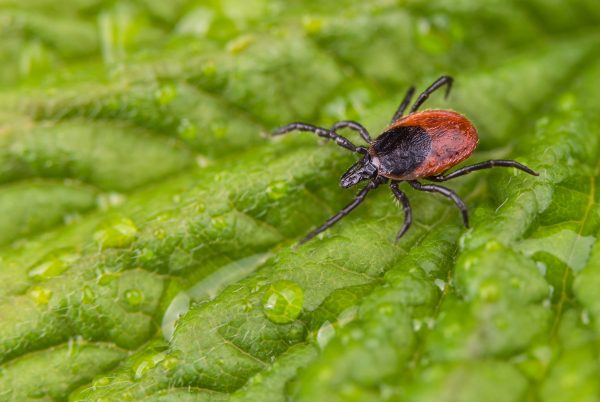How Far Can a Tick Jump?

Have you ever wondered, How far can a tick jump? If so, you’ve come to the right place! Let’s dig into the cool facts about how ticks travel so you can be better protected from the nasty little suckers.
We make no bones about it; BUGS are our business. So we make it our business to know everything about bugs. To battle bugs effectively, we have to know the answer to all kinds of bug questions. Yes, we’re nerds when it comes to bugs.
Take the tick, for example. Ticks are pests that cause all kinds of problems for humans and pets that venture outdoors. The results of their bites can range from mild skin irritations to serious health consequences. There’s a ton more to know about ticks, but we’ll focus on a few questions that may have been “bugging” you for a while.
Now, we understand that most people don’t think about ticks like we do, at least not until they become a problem. But there are a few tick questions we get quite often, one of the most common being: How far can a tick jump? This is actually more of a trick question than a tick question.
Despite being outfitted with four pairs of legs, adult ticks don’t jump at all. Each leg is covered with short, spiny hairs and ends in a couple of tiny, curved claws. Between the two claws is a small, sticky pad. The hairs, claws, and sticky pads are all designed to assist the tick in locating, grasping, and crawling onto its host — no jumping required. And it’s wired to crawl upwards once it does attach.
Unlike the enormously strong flea legs, a tick’s legs are not geared for locomotion so much as for grasping. They seem to get around quite a bit, so people often ask, “Can ticks jump and fly?” No, they can’t jump, and ticks don’t have wings, so they can’t fly either. They are essentially grounded, but not in a good way! Living close to the ground doesn’t mean ticks can’t move up in the world. They still manage to get around quite well.
So, how fast do ticks move? On their own, not very fast. If they were a vehicle, they would be a tractor, slow and plodding. But they are skilled at utilizing other means of transportation. Our response to the question “Do ticks jump or fly?” is that they don’t need to. They have found more efficient ways to get around, much to our disadvantage.
How Ticks Move in Nature
So, if ticks do not fly or jump, how do they reach your property? How do ticks travel? A tick’s primary mode of travel is on the host whose blood it feeds on. This could be an animal, a human, or both. Ticks are not too picky when it comes to transportation; they’ll take the first ride that comes along.
In the wild, a tick climbs to the top of a plant or a long blade of grass to search for a host. This host-seeking behavior is called “questing.” While holding the plant with its third and fourth pair of legs, the tick stretches out its first pair of legs, waiting for an animal to approach. Ticks can feed on mammals, birds, reptiles, amphibians, and humans. Warm-blooded hosts are their favorite. With the slightest brush, a tick can grab on and instinctively crawl upwards toward the host’s head and ears, seeking thinner skin.
The tick grasps the host’s skin and cuts into it with its claws. During this process, the tick also secretes a numbing agent within its saliva that helps its bite go undetected. Then it inserts a barbed feeding tube, and the blood buffet is open. An adult tick can remain attached, feeding, for a week to 10 days. During that time, the host continues daily life and may transport the tick several miles. Once sated, the tick releases its hold and drops off its host. Soon, it will again climb to the top of another plant to resume questing.
How Ticks Get on Humans
The most common way a tick finds a human host is through questing. This is the host-seeking behavior where the tick crawls to the top of a plant or grass stem to wait with its forelegs outstretched. When a human brushes against the undergrowth, the tick grabs on and then crawls to a preferred site to attach and feed. Sometimes, ticks wind up on tree leaves, branches, and shrubs. Although it’s more common to find ticks in low-lying areas, this is not always the case. The second most common way ticks find human hosts is through their pets. If your dog or cat is bitten, the tick may drop off in your home or yard. That proximity makes you a more likely target when the tick resumes questing. This is why it’s a good practice to inspect your pet for ticks after spending time outdoors, especially during spring and summer.
Preventing Tick Bites
The most important step to preventing tick-borne disease is learning all about tick bites and how to find them. Then, you can take essential steps for tick bite prevention. These steps include avoiding typical tick habitats like wooded and grassy areas when possible. When out hiking or walking, try to stay on designated or established pathways to avoid encountering ticks. You’ll also learn the ways to help limit ticks on your property. When walking where ticks are likely to be, wear long sleeves and pants in light colors. While ticks cannot jump or fly, they are excellent at hitchhiking a ride and will cling on if you brush past their perch. Covering your skin makes it harder for ticks to attach and start feeding, and the light clothing makes the tiny pests easier to spot.
You won’t feel a tick bite (because they anesthetize the skin before biting), so vigilance is key to remaining healthy and free of tick-borne diseases. Despite all the tick-avoidance precautions you can take, it is critical that you examine your pets, kids, and yourself for ticks when returning home from the outdoors. Showering is an excellent way to rinse away any ticks that are not yet attached. Unfortunately, washing your clothing won’t kick ticks; you’ll also have to toss them into the dryer and run it on high heat for 10 minutes to kill any tick adults or larvae. If you get bitten, properly removing the tick is essential to avoid the diseases they spread.
The Importance of Tick Testing
Testing is important if you, a family member, or a pet gets bitten by a tick. Tick testing will let you know what diseases the tick is carrying. It will not determine whether you were infected, but it alerts you to whether you need to consider treatment. Your doctor will advise you on potential treatment after receiving the test results.
When removing a tick, take care not to crush it. Instead, seal it in an airtight container or wrap it in tape. Make a note of the date of the tick bite, where on your body you were bitten, and the approximate location where you encountered the tick. Some people, especially those with a compromised immune system, prefer to test immediately. Others save the tick(s) for testing if they develop symptoms.
Protect Yourself and Your Family From Tick Bites
Although ticks do not fly or jump, they represent a health hazard for you, your family, and your pets. Ticks that carry various diseases are becoming more plentiful as development further encroaches on their natural habitat and more areas experience warmer seasonal temperatures. Therefore, it is critical that you take steps to protect yourself from these bloodsucking, disease-carrying pests.
In addition to these precautions, employing professional tick control services by your local Mosquito Joe is essential to limiting exposure to ticks around your home. We provide effective tick control as part of our comprehensive pest control services. All our work is backed by the Neighborly Done Right Promise™ and our Mosquito Joe® Satisfaction Guarantee, so you can count on excellent results. We come out to your property, tailoring our service to your specific needs. Discover effective, professional tick control near you. We have locations across the country. Our reliable pest control service is trusted by thousands of homeowners and businesses across the U.S.
Don’t let ticks keep you from exploring the great outdoors. Request a free quote at the top of this page, or call us today at 1-855-275-2563. You deserve to enjoy your outdoor spaces without worrying about tick bites. Let Mosquito Joe make the outdoors fun again.



